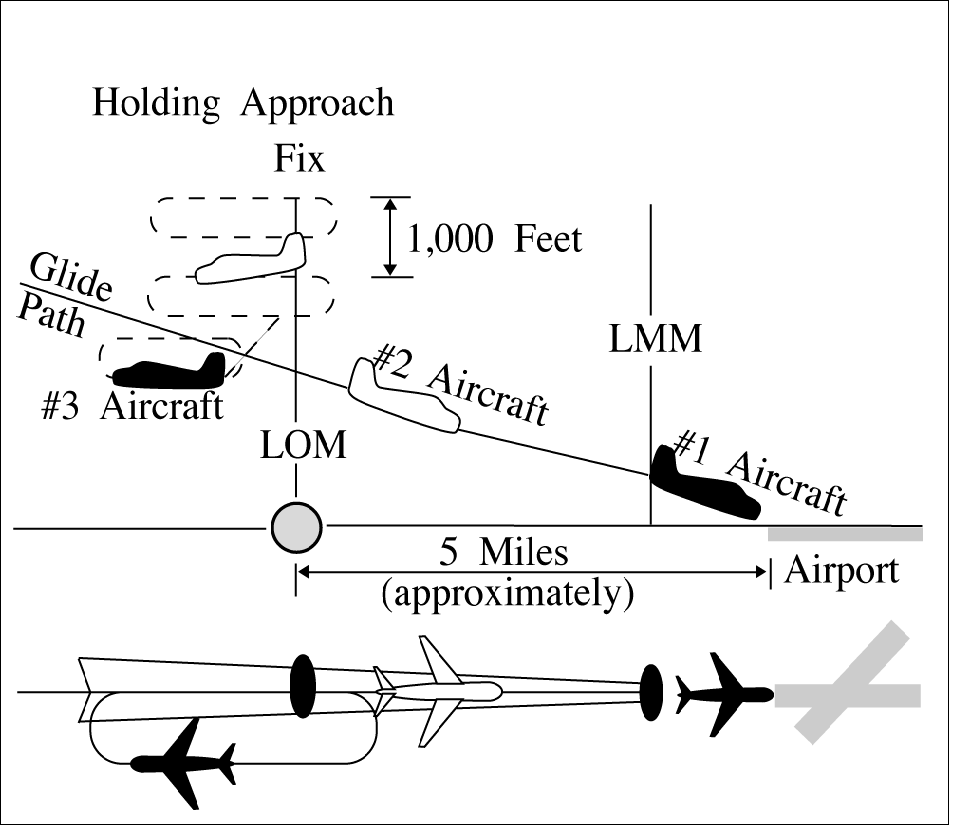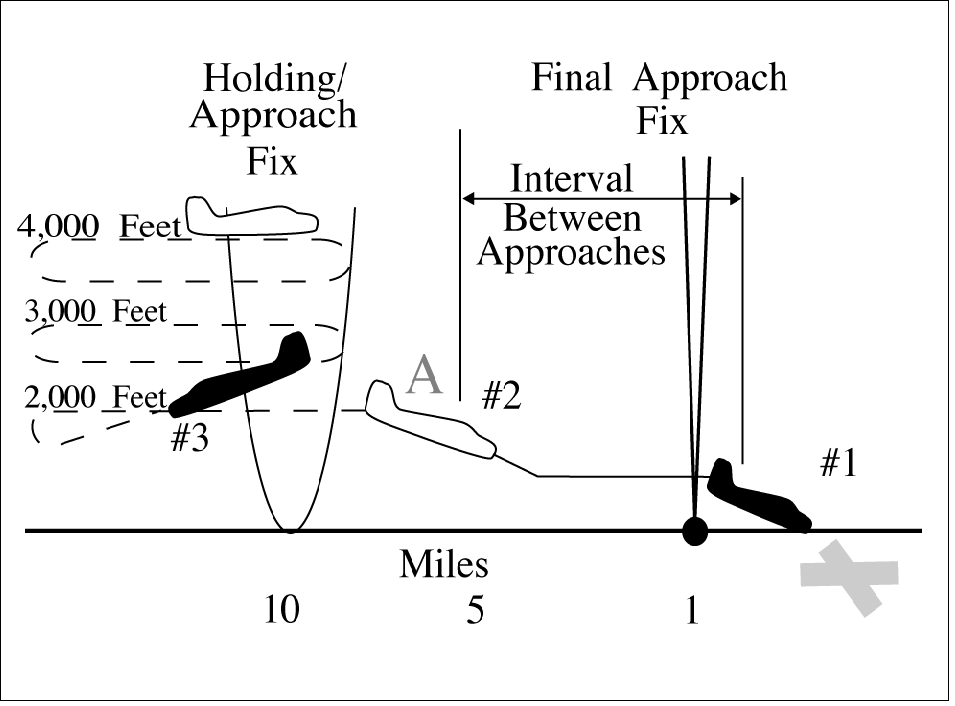Section 7. Timed Approaches
6-7-1. APPLICATION
Timed approaches using either nonradar procedures
or radar vectors to the final approach course may be
used at airports served by a tower if the following
conditions are met:
NOTE-
These procedures require NAVAIDs and standard/special
instrument approach procedures or adequate radar
coverage which permit an aircraft to:
1. Hold at a fix located on the approach course or to be
radar vectored to the final approach course for a
straight-in approach in accordance with the minima
specified in para 6-7-5, Interval Minima.
2. Proceed in the direction of the airport along the
approach course crossing the holding/approach fix at a
specified altitude if required.
3. Continue descent for an approach to destination
airport.
a. Direct communication is maintained with the
aircraft until the pilot is instructed to contact the
tower.
b. If more than one missed approach procedure is
available, none require course reversal.
c. If only one missed approach procedure is
available, the following conditions are met:
1. Course reversal is not required.
2. Reported ceiling and visibility are equal to or
greater than the highest prescribed circling minimums for the instrument approach procedure in use.
NOTE-
Determination of whether or not an existing ceiling meets
minima is accomplished by comparing MDA (MSL) with
ceiling (AGL) plus the airport elevation.
REFERENCE-
FAAO JO 7110.65, Para 6-7-2, Approach Sequence.
6-7-2. APPROACH SEQUENCE
When an aircraft passes the final approach fix
inbound (nonprecision approach) or the outer marker
or the fix used in lieu of the outer marker inbound
(precision approach), issue clearances for a succeeding timed approach in accordance with the following:
REFERENCE-
FAAO JO 7110.65, Para 5-9-5, Approach Separation
Responsibility.
FAAO JO 7110.65, Para 6-7-4, Level Flight Restriction.
FAAO JO 7110.65, Para 6-7-7, Missed Approaches.
a. Clear the succeeding aircraft for approach, to
descend to the altitude vacated by the preceding
aircraft, and to leave the final approach fix inbound
(nonprecision approach) or the outer marker or the fix
used in lieu of the outer marker inbound (precision
approach) at a specified time; or when using radar to
sequence and position aircraft on the final approach
course, vector aircraft to cross the final approach
fix/outer marker or the fix used in lieu of the outer
marker in compliance with para 6-7-5, Interval
Minima.
FIG 6-7-1
Timed Approach Procedures
Using ILS and Longitudinal Separation Only

NOTE-
FIG 6-7-1 depicts the application of timed approach
procedures using an ILS and applying longitudinal
separation only. Using an interval of 2 minutes between
successive approaches, the #1 and #2 aircraft have already
passed the outer locator (LOM) on final approach, and the
#3 aircraft has been cleared for approach and to depart the
LOM 2 minutes after the #2 aircraft reported leaving the
LOM inbound on final approach. After aircraft in the
approach sequence depart the holding/approach fix
(LOM) inbound, vertical separation is no longer provided
and longitudinal separation is utilized.
REFERENCE-
FAAO JO 7110.65, Para 5-9-2, Final Approach Course
Interception.
b. If an alternative missed approach procedure is
not available and weather conditions are less than
required by para 6-7-1, Application, subpara c, clear
the succeeding aircraft for an approach when the
preceding aircraft has landed or canceled its IFR
flight plan.
FIG 6-7-2
Timed Approach Procedures Using a Bearing on an
NDB and Longitudinal and Vertical Separation

NOTE-
FIG 6-7-2 depicts the application of timed approach
procedures using a holding/approach fix on a bearing of an
NDB and applying a combination of longitudinal and
vertical separation. The #3 aircraft has been instructed to
descend to 2,000 after the #2 aircraft has reported
departing the holding/approach fix inbound and leaving
2,000 at point A. The #2 aircraft has departed the
holding/approach fix inbound at the designated time,
maintaining 2,000 until cleared for approach at point A.
The #1 aircraft has been sighted, enabling the controller to
issue approach clearance to the #2 aircraft at point A.
c. Release the aircraft to the tower before it reaches
the final approach fix.
6-7-3. SEQUENCE INTERRUPTION
Interrupt the established timed approach sequence if
necessary to allow an aircraft to execute a different
type of approach.
6-7-4. LEVEL FLIGHT RESTRICTION
If the weather report indicates an aircraft will be in
IFR conditions over the final approach fix
(nonprecision approach) or the outer marker or the fix
used in lieu of the outer marker (precision approach)
when para 6-7-2, Approach Sequence, subpara b is
applied, clear the second aircraft for an approach
early enough to allow at least 1 minute of level flight
before crossing the final approach fix/outer marker or
the fix used in lieu of the outer marker.
6-7-5. INTERVAL MINIMA
Use a 2-minute or a 5-mile radar interval (except for
a small aircraft behind a heavy aircraft: use a
3-minute or a 6-mile radar interval) as the minimum
between successive approaches and increase the
interval, as necessary, taking into account the:
NOTE-
Increased separation is required for small aircraft behind
heavy aircraft because of the possible effects of wake
turbulence.
REFERENCE-
FAAO JO 7110.65, Para 5-9-5, Approach Separation
Responsibility.
FAAO JO 7110.65, Para 6-7-1, Application.
FAAO JO 7110.65, Para 6-7-2, Approach Sequence.
a. Relative speeds of the aircraft concerned.
b. Existing weather conditions.
c. Distance between the approach fix and the
airport.
d. Type of approach being made.
6-7-6. TIME CHECK
Issue a time check to an aircraft before specifying a
time to leave the approach fix inbound unless the
aircraft is vectored to the final approach course.
6-7-7. MISSED APPROACHES
a. If weather conditions are such that an aircraft
will likely miss an approach, issue an alternative
missed approach procedure to the next aircraft.
b. If an aircraft misses an approach, allow the next
aircraft to continue the approach if it has been
assigned an alternative missed approach procedure.
Retain radar control or hold any remaining aircraft at
assigned altitudes until traffic conditions permit the
issuance of approach clearances.
c. When para 6-7-2, Approach Sequence, subpara b is applied and the first aircraft misses an
approach, retain radar control or clear the second
aircraft to maintain the last assigned altitude
(minimum holding altitude) and return to the
holding/approach fix to hold until traffic conditions
permit the issuance of approach clearances.
|
